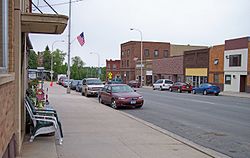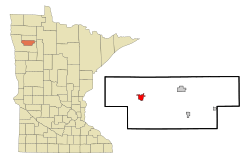Red Lake Falls, Minnesota facts for kids
Quick facts for kids
Red Lake Falls
|
|
|---|---|

Main Avenue in downtown Red Lake Falls in 2007
|
|
| Nickname(s):
Eagles and Rebels
|
|

|
|
| Country | United States |
| State | Minnesota |
| County | Red Lake |
| Area | |
| • Total | 2.10 sq mi (5.44 km2) |
| • Land | 2.10 sq mi (5.44 km2) |
| • Water | 0.00 sq mi (0.00 km2) |
| Elevation | 1,037 ft (316 m) |
| Population
(2020)
|
|
| • Total | 1,339 |
| • Estimate
(2023)
|
1,336 |
| • Density | 637.62/sq mi (246.19/km2) |
| Time zone | UTC-6 (Central) |
| • Summer (DST) | UTC-5 (CDT) |
| ZIP code |
56750
|
| Area code(s) | 218 |
| FIPS code | 27-53476 |
| GNIS feature ID | 0649866 |
Red Lake Falls is a city in Minnesota, USA. It's the main town, or "county seat," of Red Lake County. In 2020, about 1,339 people lived there. The city started as a village in 1881 and became a city in 1898. It's located within Red Lake Falls Township.
Contents
History of Red Lake Falls
Red Lake Falls has a long history! As early as 1796, a fur trading post was set up here. This makes it one of the oldest places in Minnesota where Europeans lived.
A French-Canadian fur trader named Jean Baptiste Cadotte started the post. He worked with a famous British-Canadian trader, Alexander Henry the elder. They wanted to stop another company, the Hudson's Bay Company, from trading in the Red River Valley.
The famous Canadian explorer David Thompson even stayed in Cadotte's cabin in 1798. The trading post was later closed in the early 1800s. This happened when British fur traders left the United States territory.
Settlers and Growth
In 1876, French-American settlers came to the area. They were led by Pierre Bottineau and traveled by ox cart. In 1878, more French-Canadian settlers joined them. The area became known for growing grain.
In 1878, Earnest Buse and Otto Kankel built a flour mill. It was located where two rivers meet. Soon after, Mr. Buse planned out the town of Red Lake Falls. The Kankel family stayed important in the town for many years.
The town grew because two big railways, the Northern Pacific Railway and the Great Northern Railway, built lines through it in the 1880s. These railway lines are not used anymore.
In 1896, Red Lake County was created from Polk County. Red Lake Falls became the county seat, which means it's the center of the county's government. This is still true today. The town's population was highest around 1900 and has slowly decreased since then.
Lindbergh's Visit
A special event happened in Red Lake Falls on August 27, 1927. The famous pilot Charles Lindbergh and his wife landed their plane at the local airport. They were on a tour through the Midwest. People drove them to nearby towns like Huot and Crookston.
Geography and Location
Red Lake Falls is located where the Red Lake River meets the Clearwater River. The Red Lake River is a branch of the Red River of the North.
The city covers about 2.03 square miles (5.26 square kilometers) of land. There is no water area within the city limits.
Minnesota State Highway 32 is the main road that goes through Red Lake Falls. Minnesota State Highway 92 is also close by.
Climate in Red Lake Falls
Red Lake Falls has a climate with warm summers and very cold winters.
| Climate data for Red Lake Falls, Minnesota (1991–2020 normals, extremes 1913–present) | |||||||||||||
|---|---|---|---|---|---|---|---|---|---|---|---|---|---|
| Month | Jan | Feb | Mar | Apr | May | Jun | Jul | Aug | Sep | Oct | Nov | Dec | Year |
| Record high °F (°C) | 53 (12) |
62 (17) |
77 (25) |
97 (36) |
102 (39) |
103 (39) |
110 (43) |
102 (39) |
96 (36) |
91 (33) |
73 (23) |
57 (14) |
110 (43) |
| Mean daily maximum °F (°C) | 15.0 (−9.4) |
19.8 (−6.8) |
33.7 (0.9) |
51.2 (10.7) |
65.6 (18.7) |
74.6 (23.7) |
78.9 (26.1) |
78.2 (25.7) |
68.9 (20.5) |
53.2 (11.8) |
35.0 (1.7) |
21.3 (−5.9) |
49.6 (9.8) |
| Daily mean °F (°C) | 6.0 (−14.4) |
10.0 (−12.2) |
24.4 (−4.2) |
40.6 (4.8) |
54.3 (12.4) |
64.6 (18.1) |
68.7 (20.4) |
67.0 (19.4) |
57.9 (14.4) |
43.5 (6.4) |
27.2 (−2.7) |
13.5 (−10.3) |
39.8 (4.3) |
| Mean daily minimum °F (°C) | −2.9 (−19.4) |
0.2 (−17.7) |
15.0 (−9.4) |
30.1 (−1.1) |
43.1 (6.2) |
54.6 (12.6) |
58.4 (14.7) |
55.8 (13.2) |
46.9 (8.3) |
33.8 (1.0) |
19.3 (−7.1) |
5.6 (−14.7) |
30.0 (−1.1) |
| Record low °F (°C) | −50 (−46) |
−47 (−44) |
−39 (−39) |
−11 (−24) |
15 (−9) |
25 (−4) |
35 (2) |
28 (−2) |
15 (−9) |
−4 (−20) |
−29 (−34) |
−43 (−42) |
−50 (−46) |
| Average precipitation inches (mm) | 0.60 (15) |
0.57 (14) |
0.89 (23) |
1.32 (34) |
2.85 (72) |
4.49 (114) |
3.58 (91) |
3.50 (89) |
2.81 (71) |
2.09 (53) |
0.85 (22) |
0.78 (20) |
24.33 (618) |
| Average snowfall inches (cm) | 10.1 (26) |
8.6 (22) |
7.8 (20) |
3.8 (9.7) |
0.1 (0.25) |
0.0 (0.0) |
0.0 (0.0) |
0.0 (0.0) |
0.0 (0.0) |
1.5 (3.8) |
5.6 (14) |
12.4 (31) |
49.9 (127) |
| Average precipitation days (≥ 0.01 in) | 7.6 | 6.2 | 6.7 | 7.5 | 10.7 | 12.5 | 11.2 | 9.2 | 9.7 | 8.7 | 6.6 | 8.4 | 105.0 |
| Average snowy days (≥ 0.1 in) | 7.8 | 6.3 | 4.8 | 2.2 | 0.2 | 0.0 | 0.0 | 0.0 | 0.0 | 1.1 | 4.5 | 9.1 | 36.0 |
| Source: NOAA | |||||||||||||
Population and People
The population of Red Lake Falls has changed over the years. Here's how it has grown and shrunk:
| Historical population | |||
|---|---|---|---|
| Census | Pop. | %± | |
| 1880 | 32 | — | |
| 1890 | 774 | 2,318.8% | |
| 1900 | 1,885 | 143.5% | |
| 1910 | 1,757 | −6.8% | |
| 1920 | 1,549 | −11.8% | |
| 1930 | 1,386 | −10.5% | |
| 1940 | 1,530 | 10.4% | |
| 1950 | 1,733 | 13.3% | |
| 1960 | 1,520 | −12.3% | |
| 1970 | 1,740 | 14.5% | |
| 1980 | 1,732 | −0.5% | |
| 1990 | 1,481 | −14.5% | |
| 2000 | 1,590 | 7.4% | |
| 2010 | 1,427 | −10.3% | |
| 2020 | 1,339 | −6.2% | |
| 2023 (est.) | 1,336 | −6.4% | |
| U.S. Decennial Census 2020 Census |
|||
What the 2010 Census Showed
In 2010, the census counted 1,427 people living in Red Lake Falls. There were 615 homes, and 366 of them were families. The city had about 703 people per square mile.
Most people in the city (96.1%) were White. A small number were African American (0.4%), Native American (0.5%), or Pacific Islander (0.3%). About 4.1% of the population was Hispanic or Latino.
About 29.6% of homes had children under 18 living there. Many homes (47.0%) were married couples. About 14.4% of homes had someone living alone who was 65 or older. The average home had 2.27 people.
The average age in the city was 41.2 years old. About 24.7% of residents were under 18. And 17.7% were 65 or older. The city had slightly more females (50.5%) than males (49.5%).
Famous People from Red Lake Falls
- Adrian Baril, an NFL (American football) player
- Roxy Beaudro, an ice hockey player
See also
 In Spanish: Red Lake Falls (Minnesota) para niños
In Spanish: Red Lake Falls (Minnesota) para niños


